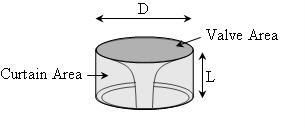We often get asked about why multivalve is better than twin.....and hopefuly we can illustrate this!
To start with, we have to learn a little about valve opening and port size and its relationship.
Ok, if we consider that the valve has a port feeding it (in the case of the inlet) then we can easily calculate the area of the port as this is approx:
Area = (
Pi/
4) x D
2Where D is the diameter of the valve.

Now, we need to work out the height the valve has to be lifted off its seat to create an opening (called the curtain area) with the same area as the port.
The calculation for this is:
Area = Pi x D x H
Where D is the valve diameter and H is the valve lift or opening.
If we now solve these two equations for H we get
H = 0.25 D
Which tells us that there is little point in opening the valve more than 0.25 times its diameter!
Reality of course is different to this because the above assumes a perfect disc with no valve stem, valve seat etc so in reality we find that the actual is closer to
H = 0.35 D
Lets put this into some perspective by considering an Omega petrol inlet valve with a diameter of 32mm
If we apply our little equation above then we will see that we get
H = 0.35 x 32mm
This gives - 11.2mm!
And we know that the standard 3.0 cam lift is approx 10.5mm so there is little to be gained by going to a high lift cam uness you have a larger valve and larger ports because the engine designers got it pretty spot on!
So, the multivale question now.
Lets consider we now have two valves and not one and for this lets use the standard Vx inlet multivalve engine valve size of 32mm from say a 2.0 16V and compare it to the size used on the earlier 2.0 8V power plant which was 41.8mm
| | 2.0 8V (20SE) | 2.0 16V (X20XEV) |
| Valve Diameter | 41.8mm | 32mm |
| Valve Lift | 10mm | 10mm |
| Total Valve Area | 1372mm | 1608mm |
| Area per valve | 1372mm | 804mm |
| Curtain Area | 1313mm | 2010mm |
So you can see that the available curtain area on a multivalve engine is much greater than the older 8v power plant despite the use of smaller valves. This gives better flow and increases efficiency by offering less restriction to the inlet gases (or exhaust)
One thing you might also note is that for the above large single valve on the 8v example, 10mm is actually not opening it enough to match the port size so a higher lift cam (approx 14.6mm) would be better!
The additional benefits of the multivalve setup are also:
Better valve cooling as there is more of the valve face in contact with the head when shut.
Cams are accelerating a smaller lighter valve which can help the engine rev higher
The position of the 4 valves means the spark plug can now be located centrally in the combustion chanber giving better and more complete combustion.
Combustion chamber shape can be much improved.
Its possible to get better swirl effects thanks to the valve layout.
Now I hear you all cry 'but twin valve setups are have more low down torque'.
Yes but, this is a consequence of the restricted flow which can help maintain high port gas speeds at the expense of (volumetric) efficiency and is easily overcome by the use of variable inlet systems (like the multiram on the V6!)

 Author
Topic: Engine theory - Part 2 - Valves! (Read 1838 times)
Author
Topic: Engine theory - Part 2 - Valves! (Read 1838 times)

